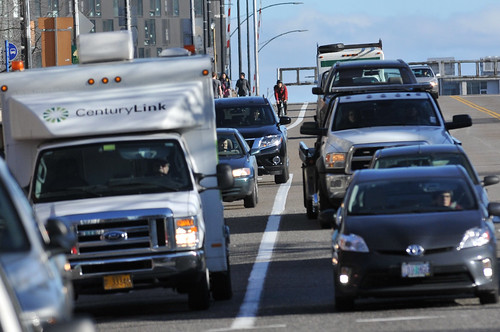
(Photos © J. Maus/BikePortland)
Welcome to Gap Week! This is our first in a series of posts where we’ll take a closer look at those annoying places where the bike lane ends.
As we shared in our intro last week, we’ve chosen four gaps where a bikeway abruptly drops then picks up again just a few blocks later. Our goal is to put these gaps on the radar of the community and staff at the City of Portland so we can get them closed as soon as possible.
Our first gap is one many of you are likely aware of: westbound Burnside Bridge between 1st and 3rd. Here’s a map for reference:
Existing conditions
The bikeway on the Burnside Bridge isn’t anything fancy, but it’s many peoples’ favorite. Unlike our other bridges, the Burnside is relatively flat and because it’s a bike lane and not a multi-use path, it doesn’t get crowded with other users who are walking, jogging, and so on.
Heading westbound (into downtown), the bike lane is 5-6 feet wide. Then it unceremoniously stops right at the big “Made in Oregon” sign. Along with the bike lane, Burnside has two standard lanes in this section. The bike lane drops to make room for a right-turn only lane which starts just about 160 feet west of the end of the bike lane. People drive about 30 mph or so here and with the slight downhill leading toward 2nd Avenue, bicycle riders can easily approach 20 mph. Right where the bike lane drops there’s a TriMet bus layover zone and then an auto-parking lane pops up. This means you’ve got to merge over toward the left whether you plan to turn right (north) on 2nd or continue straight to 3rd (and beyond).
The section from the bike lane gap to 2nd Avenue isn’t too bad because you’ve got space to operate in the right-turn only lane. But if you want to continue west on Burnside, you’re forced to share a busy traffic lane or squeeze between other traffic and on-street auto parking (not recommended).
Merging from the bike lane into the other travel lanes at these speeds and in this environment is far from the low-stress conditions Portland is aiming for.
Here are several more photos of how it looks today…
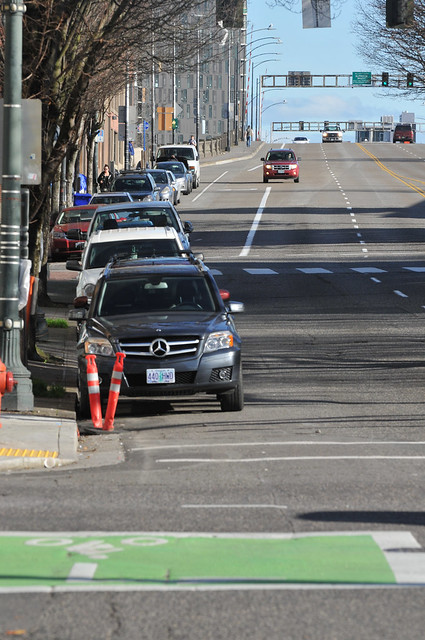
Network context
The Burnside Bridge is an important route that handles bicycle traffic from inner northeast and southeast. In 2014, the Portland Bureau of Transportation estimated there were about 2,200 people who rode past East Burnside and 6th every day (a location that feeds onto the Bridge). Compared to the other four major downtown bridges, Burnside is second-to-last in popularity with about 2,300 average daily trips (that’s about three times as many as the Morrison and about half as many as the Steel).
PBOT recently striped a new bike lane on 3rd Avenue that provides dedicated cycling space along a destination-rich corridor. Unfortunately, the bike lanes on the Burnside Bridge don’t connect to them. There are only 754 feet (about 0.14 miles) between the newly painted green bike box on 3rd and the end of the bike lane on Burnside. PBOT knows many people take Burnside to (southbound) 3rd because they’ve positioned this bike box to act as a two-stage left turn box to encourage the movement.
What the future holds
Speaking of PBOT, we asked them about this gap. They said they’ll “be looking at it” as part of their Central City Multimodal Safety Project. That project aims to build a network of new downtown bikeways and PBOT says it will begin planning them this summer. As for this gap in particular, PBOT told us “Public outreach and analysis will be needed to come up with a preferred design.”
There should be an added sense of urgency around this gap because as we reported earlier this month, Portland’s new bike share program could be up-and-running before the public process for the downtown bikeway project has even begun.
If you want to share your thoughts about this gap with PBOT, contact them via safe@portlandoregon.gov.
Stay tuned for our next gap. And we’re still taking submissions from readers. Tag your gaps with #GapWeekPDX or drop us a line with the location.
— Jonathan Maus, (503) 706-8804 – jonathan@bikeportland.org
BikePortland can’t survive without paid subscribers. Please sign up today.



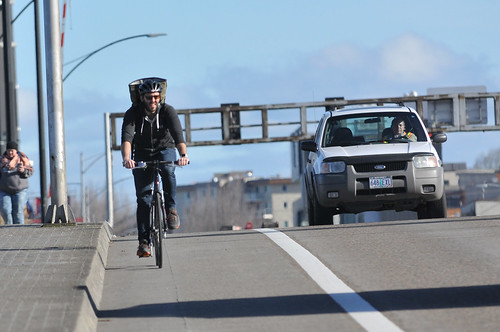
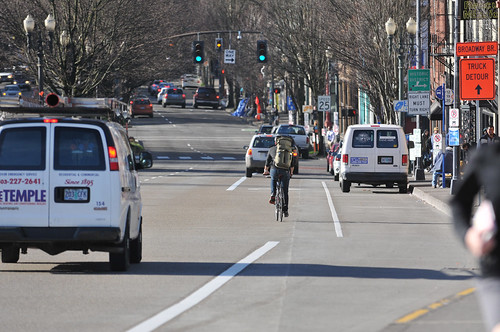
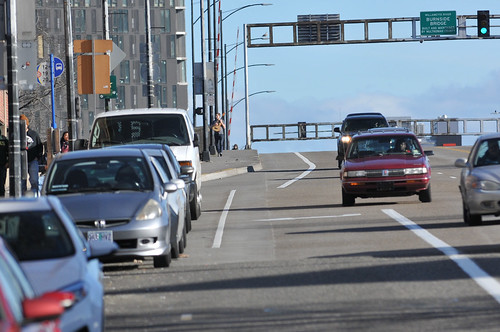
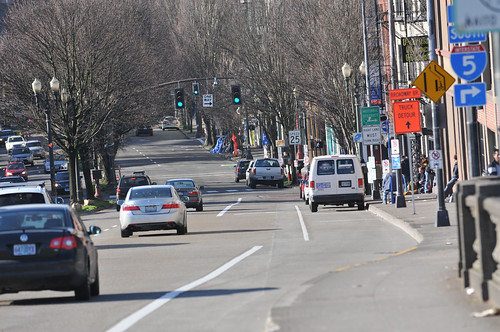
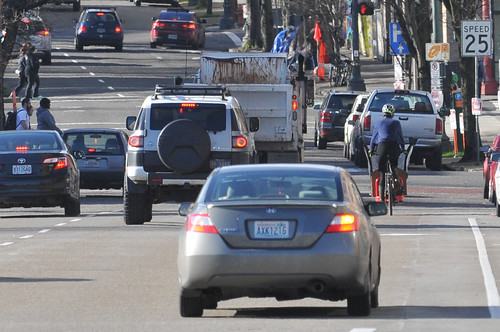
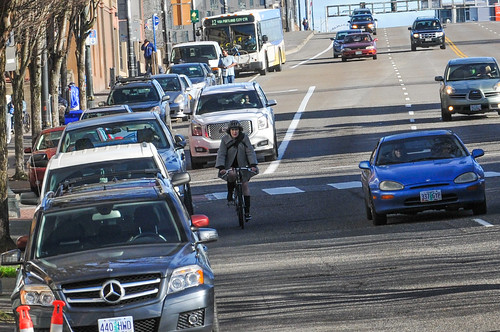




Thanks for reading.
BikePortland has served this community with independent community journalism since 2005. We rely on subscriptions from readers like you to survive. Your financial support is vital in keeping this valuable resource alive and well.
Please subscribe today to strengthen and expand our work.
Burnside remains the only bridge in the City Center without physical separation for people cycling. This gap is embarrassingly bad, but if it were up to me, I would put my efforts campaigning the county for a cycle track on the bridge itself. As far as the gap itself, the solution is a no-brainer: remove the parking lane.
Agreed, I don’t know why no changes occurred after the pedestrian fatality. Perfect opportunity. Maybe Better Block can get some temporary concrete barriers along each approach to the parts of the bridge that can be raised. Burnside is my least favorite bridge to ride (or walk) across in downtown.
Seriously, why is there any parking on a bridge? Anyone know what those spaces cost on average? I’m guessing 5x or 10x what a normal parking spot would cost in a parking structure…what a waste of money/space. Put some protected bike lanes in there.
it’s typically used by police cars and ambulances, since some of the homeless services are there.
A protected bike lane doesn’t fix the right turn mixing problem at the intersection.
It does if you have a separate signal phase for people cycling.
yeah, like on Broadway WB at I5, which is a very novel intersection. It seems like there must be another way.
How about a protected intersection?
s/cycle track/bikeway/
Terrific, in-depth reporting and pictures. The problem (even for someone like me who’s never ridden this route) is now crystal clear. And I agree with Adam, above, about removing some of that parking. Seems so obvious!
The bike lane even curves toward the parking lane! The first time I rode this, I continued towards the right and was confused when I thought everyone was parked in the bike lane.
If you have to end it, I would have done so further back, right where the lane starts to curve. That would have put you center of the turn lane, before cars started moving into it. The responsibility to merge would have been on the overtaking cars.
Unfortunately, someone apparently decided they wanted bikes to stay on the right edge.
I am assuming the mention of the Broadway Bridge in the 3rd paragraph should be the Burnside Bridge.
Yes Mark. You are correct. Thanks for pointing it out. My mistake. Fixed it.
JM, you also state “PBOT recently striped a new bike lane on 3rd Avenue, that provides dedicated north-south cycling space along a destination-rich corridor.”; but isn’t this only a southbound corridor?
Yes it’s only southbound. I should have been more careful with that sentence. I’ll clean it up. Thanks.
I would take the Burnside bridge way more often if it was safe to do so. From my girlfriend’s house to my work is less than a 10 minute bike ride if I go over the Burnside. But, if I’m riding to work, it’s at rush hour, which means it becomes very unsafe to ride there.
Detouring to the Steel or Hawthorne doubles the amount of time it takes to get to work.
That’s interesting that you feel more unsafe during rush hour. Rush hour is actually the only time I have no issue riding the Burnside Bridge because cars are so slowed or stopped I feel very little danger from speed or sudden movements. I take Burnside during the evening rush quite a bit to reach PRG or restaurants on E. Burnside- and I feel infinitely more safe than when it’s free flowing.
During the morning rush hour, there’s a bunch of cars and trucks turning right on Grand AND the situation at 2nd is pretty bad.
Going Eastbound can be nicer when car traffic is stalled, but that also means that there will be a bunch of impatient drivers who will cut across the bike lane to turn onto MLK. I’ve been nearly hit there every time I go across the bridge.
I use this a bit- whenever I go visit fellow cyclist @kitchen, basically, so once a week or so. When I remember, I turn right onto 2nd to Flanders, heading towards NW).
I really don’t know the best way to fix it for cyclists going straight through, since it’s an often-used right-hand turn. Putting it on the other side of parked cars makes the intersection more dangerous. A mixing zone with dotted green paint would work, I suppose.
That would be my choice. Get everyone in the right place before the turning begins.
This gap is the most treacherous part of my otherwise safe inbound morning commute.
I use this almost daily and find the Burnside bridge the better bridge to use for so many reasons. That doesn’t mean that it is that much safer but I manage it fine. After the Couch/Grand was fixed with lights I have had fewer incidents there from right turning vehicles. I do see the crowding going onto the bridge that they tried to fix with bumps. From my rides I see mostly buses running over the bumps. But the bike lane is wide, there are no pedestrians stepping in front of you, and it is wide enough to be able to pass easily. It is also easy to get at as long as you come up at the point the bike lane starts on Couch.
Yes, it was terrifying at first coming down and having the bike lane disappear. I have become good at watching and staying in the turn lane until I can move over to go up to 3rd or 4th avenue. I do take the lane on Burnside, actually on any downtown street, so don’t feel that I have to worry about being hit by a turning vehicle. I move over into the through travel lane in a break in the cars which somehow always materializes when I need it. But then I start watching early on. I don’t ride next to parked cars or thread the lanes as this to me is dangerous with the way that drivers react. I used to go the 4th and then up to Glisan but now go on 3rd with the bike lane and turn north on Taylor. The loss of a bike lane on Jefferson at the construction should be a crime. There are not that many east/west routes with bike lanes and Oak/Stark does not work for me. How about those gaps caused by construction? Why are they allowed?
I worry about extending the bike lane unless it is extended at least to 3rd or 4th as the cars will want to move over to turn and this will cause problems. I would think that this problem needs signs that all drivers read and heed to allow bicyclists to move over when needed. In some ways I think it is safer to have the bike lane end where it does than have it end at 2nd. So unless it is extended to at least 4th I think that the current solution is the best we can hope for except for signage, maybe.
Congratulations, you’ve made a miserable evening commute on the 12,19 and 20 even worse with your suggestion.
Something tells me you don’t ride any of these bus lines on even an infrequent basis. I bike commute home to NW everyday, and I frequently see these buses stuck in gridlock. This city needs to start thinking seriously about dedicated transit lanes wherever we can put them, without needing millions of dollars in NEPA studies.
The solution is to have bus lanes AND bike lanes. As someone who’s taken the 12, 19, and 20 a bunch of times, they absolutely need a lane of their own, especially eastbound. Eastbound is also the easiest to do geometrically, but I would support one lane per direction, per mode. Seems fair.
Yes, the eastbound merge across the bike lane to the right turn only lane can be stressful. I sometimes see maniacs try to cut me off in the right turn lane well beyond the green conflict zone, even when I’ve already established my position in that lane as I make my way south onto MLK (and then I end up in the streetcar lane but that’s another problem altogether).
“People drive about 30 mph or so here and with the slight downhill leading toward 2nd Avenue”
you meant 40 mph… it’s a 35 mph zone across the bridge so people are only slowing to 30 if you’re lucky at this point…
I either take 2nd ave right then left on Couch to 3rd. Otherwise if the light permits I take the traffic lane as I am still doing the traffic speed coming off the bridge until the park blocks, past Broadway.
I almost always take the 2nd Ave right turn and ride on Couch even though it’s stop/start. Don’t feel comfortable riding the gap area on Burnside.
I agree. I’ve had no real problem with the Burnside bridge with daily riding for 10+ years, except that gap between 2nd and 3rd. I always circle around to 3rd southbound via Couch. I feel a little dumb doing that with that new green turning square, but I still feel safer on Couch.
I hope you will explore the hell that is NW Everett heading eastbound, after you go over the freeway. Left-hand bike lane that poof! Disappears and suddenly you’re all alone and on the wrong side of a fast-moving, one-direction road. I take my kids on it from one school to another and stress out every time. Thanks!
Apparently I have a tendency of stressing out the motor traffic on Everett. I continue in the left traffic lane after merging from the bike path that becomes the left turn lane. I then stick there until I come to a construction zone that gets me around the traffic into the right lane after passing 10-20 cars. If a bus is stopped I again swing into the left lane and continue to either Naito or catch the MAX at first.
This is a good one to start with, and I hope the $6mm project will look at improve the bike connections on the west end of this bridge. But I have to wonder: Why does this article only focus on the WESTBOUND gap? Doesn’t the eastbound gap merit discussion as well? Moreover, why doesn’t this article encompass W Burnside to Broadway, if not all the way to the Park Blocks?
At the very least, we would have bike lanes in both directions east of 3rd. That way someone could go southbound on 3rd and turn onto Burnside going east. That block is currently just loading zones and a bus zone, so no parking would have to be removed.
The bike lanes on the Burnside Bridge really need to extend (in both directions) to the Transit Mall, or better yet the Park Blocks. Getting them to the Transit Mall and adding floating bus stops would eliminate the bicycle-bus leap frogging problem that’s particularly bad at that location. Extending them to the Park Blocks would create a great connection into the future Green Loop.
Given that Burnside has 6 or 7 lanes between the river and SW/NW Park Avenue this should be doable. If PBOT is willing to narrow E Burnside down to 3 general traffic lanes they should also be willing to narrow W Burnside down to 4 or 5.
Nice gap! It’s a doozy. Can’t wait to see which others will get top billing.
Burnside works well for me as it is. I ride west over the bridge, then merge left as the bike lane ends. I take the right lane on Burnside all the way past the Park Blocks, then turn right on 9th to get to Couch. Traffic doesn’t move that fast once you’re off the bridge, and there’s a whole other lane if someone feels the need to pass me. My issue with Couch is that it’s much slower with all the dumb stop signs.
A frequent ride for me.
Westbound:
– NE Couch to Burnside Bridge works fine, with the bike lane plus the downgrade allowing cyclists to keep up with cars, plus signal timing holding cars to about 20 mph. Right hook at Grand is a risk, but the very visible lighted signage helps and both drivers and cyclists usually seem pretty alert here. The S-curve is okay, despite the irritation of cars/buses cutting into the buffer, because they very seldom cut into the lane itself.
– This doesn’t matter for cyclists, but do you notice how cars get backed up on NE Couch during morning rush hour, despite the signal timing?. It seems like the signal timing does not adjust when the street is full of cars. So if you are at a red light, when it turns green, you cannot drive until the cars on the block in front of you move, but they don’t get their green until a delay after you got yours, and they in turn are unable to drive until the cars on the block ahead of them get their green, etc. I think the city should consider adaptive signal timing there.
– The bridge itself is fine. Yes, the bike lane is merely paint and cars are going 35-40 mph, but they are in wide lanes and you can always ride on the sidewalk if you really want separation. I would not like to see barriers between the bike and traffic lanes here, because then every other cyclist would get bottled up behind the riders going 5 mph, who are often a bike delivery rider pedaling a wide trike.
– W Burnside is fine for the first block (to 2nd) since the road is very wide and the right turn lane is also wide. But the block from 2nd to 3rd is a problem. The simple solution would be to remove street parking between 2nd and 3rd; the businesses on that block are social service/missions, whose “customers” (people seeking housing, food, help) do not arrive by private car (although they are sometimes taken away by ambulance/police car) and there are no retail stores there.
Eastbound:
– The E Burnside approach to the bridge used to be fine, because the right most lane was only used by buses and cars turning right. It was thus a safe place for cyclists, albeit kind of slow if you got stuck behind a bus. But the road is being restriped now, and that rightmost lane may no longer be as nice – time will tell, and this could be a problem. Anyone know what this will look like?
– The bridge itself is, again, fine. Same comments as westbound. Some people think the three eastnound lanes could be reduced to two. I don’t think that is necessary, but it probably wouldn’t make any difference to car traffic, because the bottleneck for drivers isn’t the bridge, it is E. Burnside.
– E Burnside is okay, if (and only if) the cyclist in the bike lane is alert to the risk of right hooks. The lights are timed to a slow speed (20 mph?) and there isn’t usually too much contention with buses stopping.
– For drivers, during rush hour, even with the signal timing, E Burnside gets backed up to 12th. This is because the signal timing does not adjust when the street gets filled with cars – same issue as NE Couch westbound. This doesn’t matter to cyclists.
TL:DR version: remove street parking on westbound W. Burnside to 3rd, it won’t deprive any of the missions of their clients, and it will allow cyclists to easily connect to the future bike network on 3rd.
I took a closer look at the approach from W Burnside to the bridge, after the restriping. It is now much worse. Where there used to be room for bikes, there is now none.
“…it doesn’t get crowded with other users who are walking, jogging, and so on.”
If there’s a constant refrain on BP it’s “words matter.” Perhaps you could train that refrain on “jogging” — it’s running, not jogging. Like it’s “people on bikes” not “bikers.” The sport is running, people are runners. Thanks.
Thanks Ben. I always like getting new feedback on this type of word choice. But in this case, I essentially wrote, “other users [of the trail] who are jogging.” Is your beef with the term “jog”? Is that considered demeaning to people who run?
Yes, runner is preferred over jogger. It’s not that it’s inherently demeaning but when you look around this city it’s as much a running city as it is a biking one with the large numbers of runners of all abilities. So let’s call the people who pursue it runners rather than joggers.
I believe the modern term is “people of running”.
Some people run; some people jog. In my experience both types of people love nothing more than to go the wrong direction in a bike lane despite a perfectly good sidewalk being a few feet away.
I’ll give you the runner’s perspective. The sidewalks are uneven at many of the segments (every 6-10 feet). This is a trip and injury hazard. Also, at every driveway and intersection the sidewalk dips or slants towards the road to allow car access. Over the course of many miles, this adds wear and tear and increases injury risk, especially towards the end of a run. Imagine bike lanes were built with speed bumps and random dips while a perfectly smooth and frequently underutilized road ran alongside. Would you ever *not* take the car lane?
That said, while I use the bike lanes whenever I feel it is safe to do so, I do yield to oncoming bikes and move to the sidewalk if there is room.
We’ve been here before many times. Sidewalks are often in disrepair with cracks, upheaving sections, tree roots, etc.
If you want to talk transgressions by folks, people who cycle have lots on their score card. Let’s not go there, shall we?
If you want to see the gap bridged, share your thoughts with Mike Pullen, director of the Multnomah County Bridge department, which owns and operates the bridge.
mike.j.pullen@multco.us
Ted Buehler
Technically, you are right. The bridge is MultCo’s. However, the driving surface of the bridge and its approaches are actually operated by PBOT.
Okay, send it to SAFE@portlandoregon.gov, then.
Squeaky wheel gets the grease, folks.
Make yourself heard and your needs known.
Don’t spend your whole life sucking hind teat..
#suckinghindteat
https://answers.yahoo.com/question/index?qid=20080510132207AAbHB37
Ted Buehler
Nope, this one is entirely under PBOT jurisdiction.
Also, people in cars regularly travel at 50 mph on the bridge, not just 40.
https://m.youtube.com/watch?v=1UJwJEgTEhU
Ted Buehler
PBOT should immediately mark the far right eastbound lane as bus-only, from 6th ave all the way to MLK. This will slow down average speeds for cars, and get the buses out of this traffic. Absolutely ridiculous that they have three striped eastbound lanes on this bridge.
It can probably go all the way to the SE 12th as long as there are three travel lanes; at the very least it must get buses past the clusterf*** at Grand.
Chris,
Absolutely ridiculous is an exaggeration.
November 2015 volume counts east of SW 2nd found a 4 PM peak hour count of just over 1900 trips, followed by over 1800 the next hour. The rule of thumb is 1000 vehicles per hour per lane. It’s bumping up against crossing the 3 lane threshold. I would agree that there is likely capacity at some of the other bridges that could take more of the load, so a road diet is still feasible.
Do you think, in your professional judgment, that the Burnside-Couch couplet has made traffic in this area worse by allowing drivers to make left turns from Burnside EB to Grand NB to access the I-84 ramp at Everett? Previously this left turn was forbidden when Burnside was two-way.
That seems to be the opinion at TriMet, which has dealt with greater slowdowns for the #6.
1000/hr/lane and you say there are 1900 so we need three lanes for cars? Maybe PBOT needs a rule of thumb that travel lanes and parking will be given over to bikeways until we meet our mode-share goals. That is, if they actually are goals.
Anyone that observes the eastbound traffic can recognize that the light at MLK/Grand is the bottleneck. 3 lanes are not needed on the bridge, because the throughput of the light is lower than 3 unobstructed lanes on the bridge.
Even if your data is correct, are we the type of city that will let buses sit in traffic because the existing observed vehicle counts are close to theoretical capacity? That is what I find ridiculous.
It is that light, but also the cars turning left off Burnside which blocks the left most lane for a good part of each green light. If you also have a bus stopping on the right most lane, then E Burnside gets really bottled up.
Maybe left turns should be banned, as they used to be before the couplet…
Until just recently, there were no left turns permitted between the park blocks and the bridge. I have no idea why they added that left turn lane, and it should be removed. Two through lanes with no left turns, and a Bus/Bike lane should be the eastbound configuration.
Burnside was recently restriped so there are actually only two through lanes west of 3rd (to accommodate a left turn at 4th). So I think the bus lane should start at 3rd on the westside, and go to 12th on the eastside.
I sent a link to this article to my fellow members of the Multnomah County Bicycle and Pedestrian Citizen Advisory Committee. We have been discussing a big maintenance project on the bridge that is coming up. However, while the county owns the bridge to the first intersection, the city is responsible for traffic control. The jurisdictions typically coordinate decision making about these things.
Why are we so far behind other cities in the usa?
Many of the emergency shelters in Old Town Chinatown rely upon volunteers and people driving with donations from around the metro area and even visiting from other states. They often park big vans in front of the missions. UGM has a truck that drives close to a thousand miles per week getting donations for the homeless.
The vehicles parked there (W Burnside between 2nd and 3rd) are usually passenger cars, and they are not being actively unloaded. More loading zones on 2nd and 3rd would take care of any loading/unloading needs.
Why do I feel like BikePortland asked its readers to name the city’s worst gaps, then ran with the four they’d already chosen?
Part of an elaborate conspiracy.
I don’t know Champs.. Why do you feel that way?
Seriously.. We never said readers would pick the gaps we highlight. We said we’d round up reader submissions on Friday.
For want of a bit of paint and a few hours, we could have a proper lane up to 2nd with a defined mixing zone (dashed lines) and associated right-of-way. And, a block of parking-protected lane (ending at 3rd, a one-way to the left, thus no right hooks.)
Actually, that parking could just be moved one block to the west, to the block between 4th and 3rd, which is currently marked “no parking” even though there is space.
You want a preferred design, PBOT? Remove the fricking parking and put in a bike lane! There, I just saved a lot of outreach time.
I use this bridge daily for my commute to and from PSU, having switched over from the Hawthorne several years ago. I’ve joking referred to it as the “pro’s bridge” because of the bike lane rather than multi-use trail format. Personally, I will always prefer this environment over mixing with pedestrians, especially under constrained conditions like the Hawthorne or Steel.
But all joking aside, I think this is a reasonable facility until you reach the west side. The vast width of Burnside with its through lanes, dedicated turn lanes, medians, and parking lanes, yet no bicycle facility at all, is a clear indicator that those who choose to ride aren’t welcome downtown. At least not to the level of the east side. Also, I would argue the “gap” extends all the way to Broadway or the Park Blocks. Plenty of right of way out there…